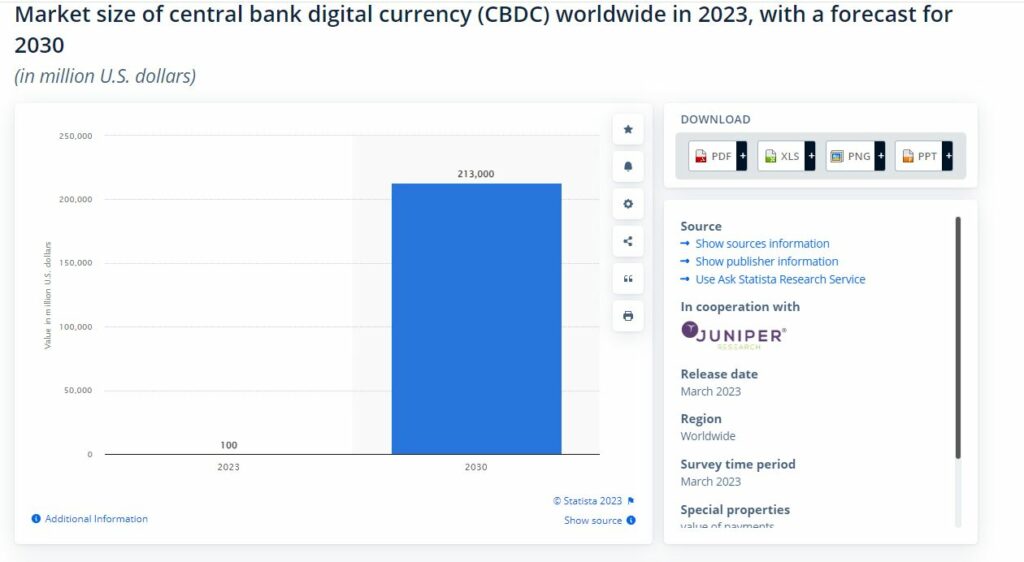
YEREVAN (CoinChapter.com) — The Monetary Authority of Singapore (MAS) will initiate a pilot program for a Singapore CBDC — a backronym for “Central Bank Digital Currency” — for bank settlements.
Announced by MAS Managing Director Ravi Menon at the Singapore Fintech Festival on Nov. 16, this marks a shift from previous simulations to real-world trials with local banks. The pilot aims to enable instant settlement of payments among commercial banks using the newly introduced CBDC.
I am pleased to announce that MAS will pilot the ‘live’ issuance of wholesale CBDCs to instantaneously settle payments across commercial banks,
asserted Menon.
What is Singapore CBDC All About?
CBDCs are digitized versions of fiat currencies, albeit running on a centralized blockchain.
In other words, Singapore CBDC theoretically presents a segway into the domain of cryptocurrencies without giving up governmental control. So far in 2023, twelve countries have started exploring blockchain technology, bringing the so-called “curious” bunch of CBDC wannabes to 131.

US is Lacking Behind CBDC Race
Unlike the Singapore CBDC announcement, the US has refrained from pursuing its digital dollar plans actively.
It appears the US Federal Reserve is not in a hurry to commit, despite lengthy investigations. This decision hinges on support from the legislative and executive branches, as officials cite risks of disrupting existing financial structures and losing monetary autonomy.
In a report on Nov. 13, Bank of America representatives asserted that the Federal Reserve will unlikely implement CBDCs, at least in the short term. Nonetheless, The firm reiterated that blockchain technology could “revolutionize global financial systems” to provide a more efficient and less costly cross-border payment system.
However, CBDCs may also “drive competition with bank deposits, more frequent bank runs, loss of monetary sovereignty and tensions among countries globally,” the bank said.
Do the “countries globally” agree? Let’s take a closer look.
Europe Preparing for the Digital Euro
The European Central Bank has moved into a preparation phase for a digital euro while underscoring offline capabilities, high privacy, and instant settlements. Considering macroeconomic challenges like energy dependence and inflation, the digital euro could be a step toward economic resilience.
For example, The Swiss National Bank (SNB) said earlier this month that it was working on a wholesale CBDC pilot alongside the SIX Digital Exchange (SDX) and six commercial banks.
Latin America and Asia-Pacific jump on the bandwagon
Argentina is exploring a CBDC to mitigate economic instability and rampant inflation.
With an economy expected to contract by 1.6% in 2023, according to Reuters, a digital currency could offer a new economic lever. Brazil, on the other hand, is developing the digital real (DREX) for a planned launch in May 2024, underscoring the importance of privacy and infrastructure.
Similarly, the Reserve Bank of Australia and several commercial banks collaborated on a CBDC blockchain pilot in 2023.
China, a front-runner in CBDCs, completed its first international crude oil trade using the digital yuan, showcasing its digital currency’s global applicability. The Indian economy joined in as well, setting targets for daily transactions with its CBDC.
Meanwhile, Japan is piloting a digital yen, aligning with its modest economic growth forecasts. Nepal also plans to develop a CBDC despite its restrictive stance on cryptocurrencies.
12 countries have launched the service already
Conversely to the aforementioned cases, The Bahamas, Eastern Caribbean, Jamaica, and Nigeria have already implemented retail CBDCs. However, it represents a triple growth from 2021.
Bank for International Settlements (BIS), a Switzerland-based body owned by 63 central banks representing around 95% of the world economy, conducted a global study on the state of CBDCs in 2022. The said research found that nine central banks had indicated they’re “very likely” to issue a CBDC for wholesale use in financial markets within the next six years.
However, as of November 2023, only 12 countries have officially launched digital versions of their fiat currencies, including the Bahamas, Kazakstan, Nigeria, and several islands in the Caribbean.
Notably, Kazakstan was the latest addition to the team. During his speech at the XI Congress of Finance in Almaty on Nov. 15, the chairman of Kazakhstan’s National Payment Corporation (NPC), Binur Zhalenov, made the first CBDC payment as a demonstration, according to the local news outlet, Kapital.kz.
The global market size of CBDCs stood at 100 million in 2023, with a projection of 213 billion by 2030.



